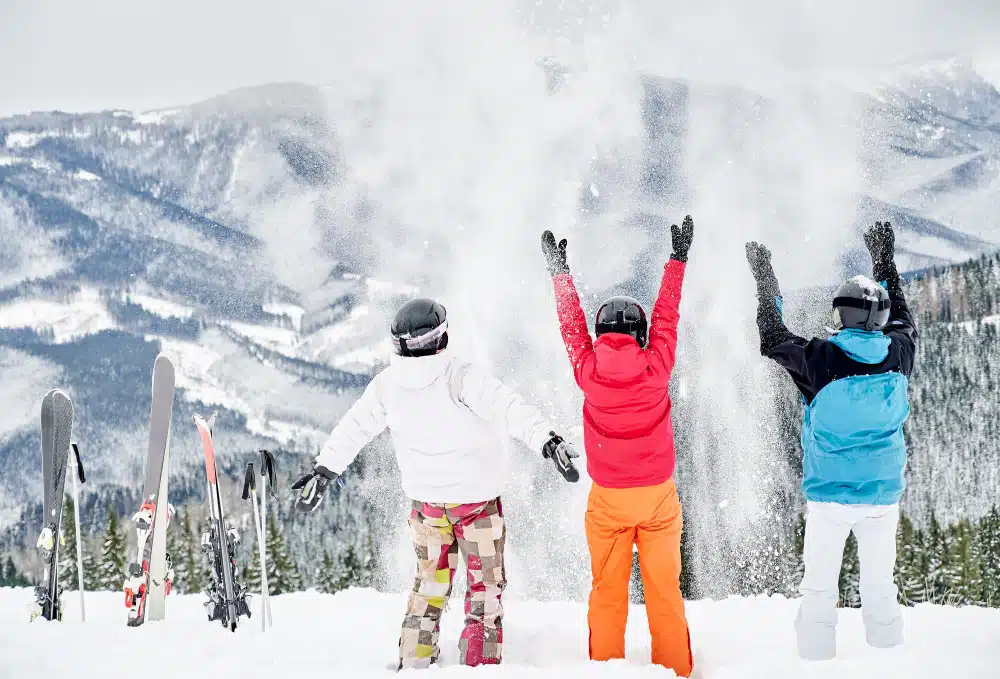Essential Ski Gear
A crucial part of what to pack for a ski trip is selecting the right ski gear. Your skis, snowboard, poles, and boots are the foundation of your skiing experience. Choose gear that matches your skill level and the terrain you’ll be exploring.
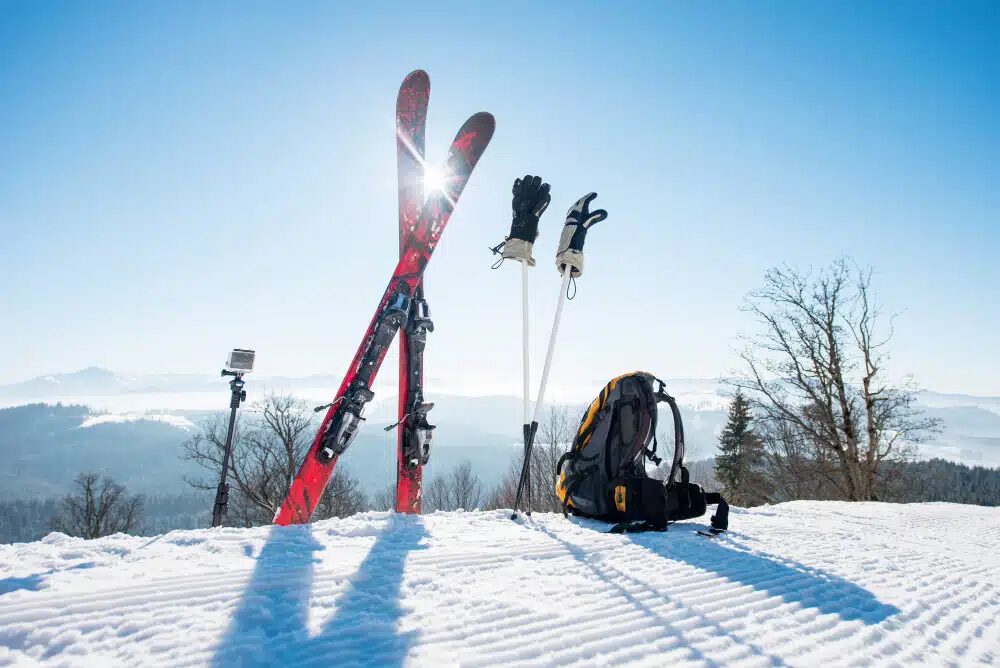
1. Skis, Poles or Snowboard: Choosing the Right Equipment
When packing for a ski trip, it’s vital to choose skis, poles, or snowboards that match your skill level and the specific conditions of the resort. Beginners should consider shorter skis and snowboards for better control, while intermediate and advanced enthusiasts may prefer longer equipment for increased speed and stability.
The type of terrain is also important – opt for powder skis in deep snow, carving skis on groomed runs, or all-mountain skis for versatility. Snowboarders should select boards based on their riding style, whether it’s freestyle, freeride, or all-mountain. Additionally, the right poles can enhance balance and rhythm in skiing.
And with 4F Transfers, you don’t have to worry about gear transportation; their spacious vehicles are designed to handle your ski equipment with ease.
2. Ski Boots and Snowboard Boots: Tips for Comfort and Performance
Comfort and performance are key when selecting ski and snowboard boots, an essential part of what to pack for a ski trip. Boots should fit snugly but not too tight, allowing for good circulation and warmth. Custom insoles can provide additional support and comfort, a worthy investment for those spending long hours on the slopes.
For skiers, the flex of the boot should match your skill level: softer flex for beginners and a stiffer flex for experienced skiers.
Snowboarders should look for boots that offer a good balance of flexibility and support, suitable for their riding style.
3. Helmets and Goggles: Safety First Approach
Safety should always be a priority when considering what to take on a ski holiday. A helmet is non-negotiable. It should fit well, be comfortable, and meet safety standards. Goggles are equally important for protecting your eyes from UV rays, wind, and snow. Look for goggles with good UV protection, anti-fog features, and a fit that works with your helmet.
Remember, visibility is key in ensuring a safe and enjoyable skiing or snowboarding experience.
Ski Clothing Essentials
When considering what to pack for a ski trip, clothing is next on the list. Effective layering is essential: start with moisture-wicking base layers, add insulating layers for warmth, and top with waterproof and breathable outerwear. Accessories like gloves, socks, and neck gaiters are also vital to keep you warm and protected. Read further and get to know what clothes to take on a ski holiday.
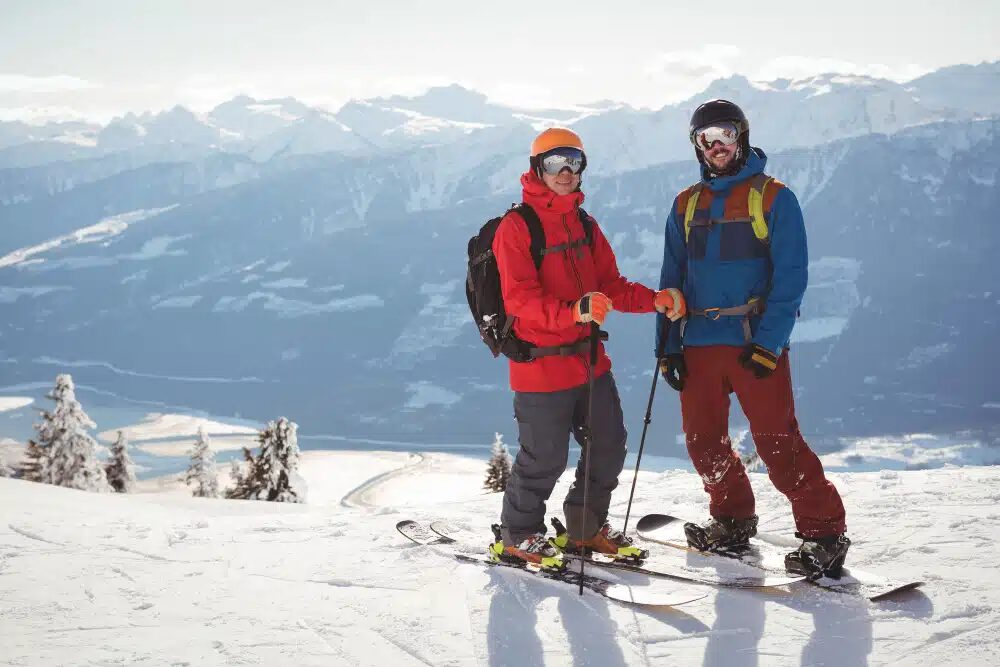
4. Base Layers: Keeping Warm and Dry
Base layers are vital for maintaining body temperature and wicking away moisture. Opt for materials like merino wool or synthetic fibers that keep you dry and avoid cotton as it retains moisture. Fit is important – snug but not restrictive – allowing for movement and comfort in varying conditions.
5. Insulating Layers: Balancing Warmth and Mobility
Insulating layers trap body heat while allowing breathability. Choose from fleece, down, or synthetic materials based on the weather. The goal is warmth without sacrificing mobility, so layer accordingly for optimal comfort and temperature control.
6. Outerwear: Waterproof and Breathable Jackets and Pants
Select jackets and pants that are waterproof and breathable to protect against snow and wind. Look for features like sealed seams and snow skirts in jackets, and durability in pants, especially in high-wear areas. Adjustable ventilation can help regulate body temperature during active skiing or snowboarding.
7. Accessories: Gloves, Socks, and Neck Gaiters
For accessories, waterproof gloves or mittens, ski-specific socks, and neck gaiters are essential. Gloves should offer insulation and a secure fit, while socks made of wool or synthetic fibers provide cushioning and moisture management. Neck gaiters offer adjustable protection for your face and neck against the cold.
Personal Items and Gadgets
In your what to pack for a ski trip checklist, don’t forget personal items and gadgets. Sunscreen, lip balm, and moisturizers are essential to protect your skin. For capturing those breathtaking moments, pack your action camera, smartphone, and don’t forget the chargers and adapters.
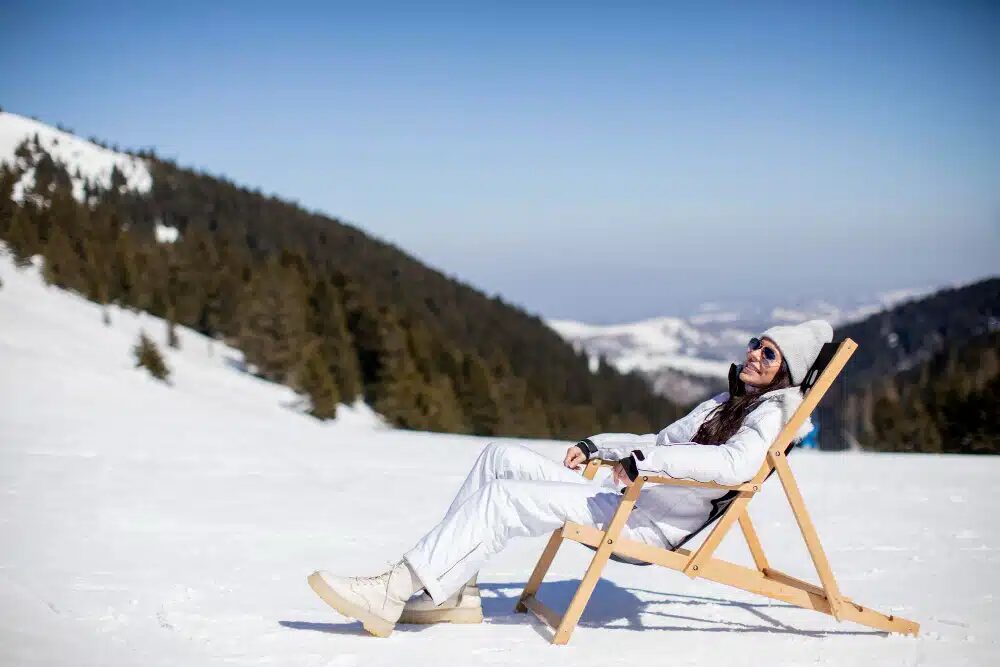
8. Personal Care: Sunscreen, Lip Balm, and Moisturizers
Essential for ski trips, sunscreen protects against UV rays reflected by the snow. Choose a high SPF, broad-spectrum sunscreen. Lip balm with SPF is crucial to prevent chapped lips in cold, windy conditions. A good moisturizer combats the drying effects of the cold, keeping your skin hydrated.
9. Gadgets: Action Cameras, Smartphones, and Chargers
Pack an action camera like a GoPro for capturing your ski moments. Ensure your smartphone is protected with a waterproof case and bring extra batteries or a portable charger, as cold temperatures can drain battery life quickly.
10. Travel Adapters and Power Banks
A universal travel adapter is vital for international ski trips, accommodating different plug types and voltages. Power banks provide a convenient charging solution for your devices, especially useful during long days on the slopes where power outlets are scarce. Choose a high-capacity model for extended use.
Travel Essentials
What to pack for a ski trip also involves considering your travel essentials. Keep your travel documents, insurance, cash, and credit cards organized and accessible. Maps and guidebooks can enhance your experience at the ski resort.
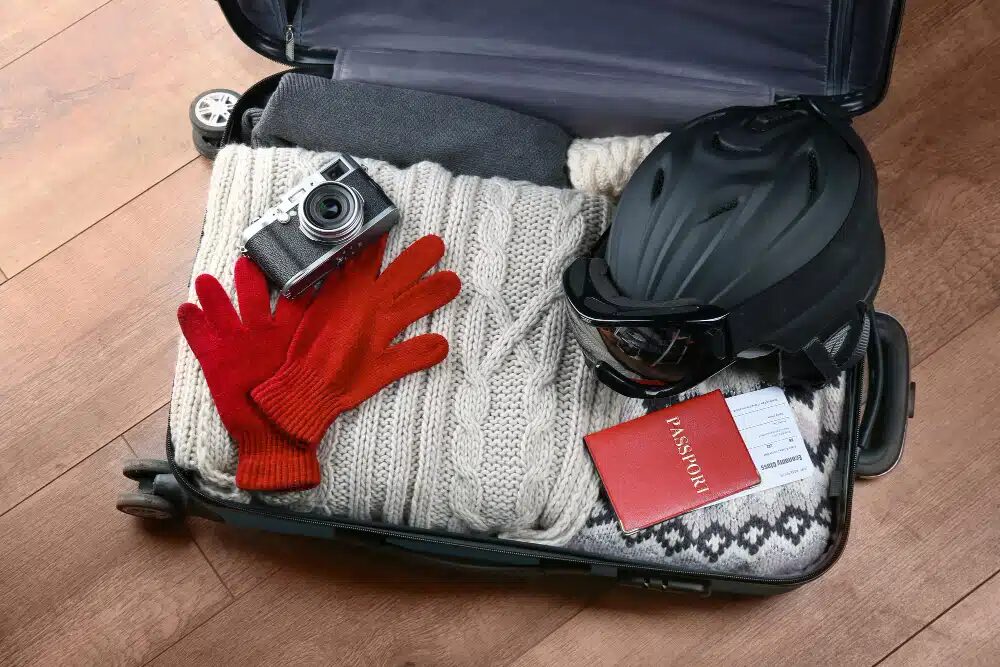
11. Travel Documents: Passports, Tickets, and Insurance
Always carry essential travel documents like passports and tickets, ensuring they’re up-to-date and easily accessible. Travel insurance is crucial for ski trips, especially policies covering winter sports, to provide protection against any unexpected incidents. This preparation is key for a hassle-free journey to your ski destination.
12. Cash and Credit Cards: Currency Considerations
Understanding the currency at your ski destination is important. Carry a mix of local cash for small purchases and credit cards for larger expenses. Informing your bank about your travel plans can prevent any issues with transactions abroad, ensuring financial readiness for your trip.
13. Maps and Guidebooks: Navigating Ski Resorts
Maps and guidebooks are invaluable for navigating ski resorts, providing detailed information on trails, lifts, and local amenities. They enhance your skiing experience by guiding you to the best spots. Additionally, downloading the resort’s mobile app can offer real-time updates and interactive maps, making it a handy digital guide.
Comfort and Convenience Items
When finalizing what to pack for a ski holiday, include items for comfort and convenience. Snacks, hydration, entertainment like books or music, and if traveling with family, some child-friendly items.

14. Snacks and Hydration: Staying Fueled and Hydrated
Packing snacks and staying hydrated are essential for maintaining energy levels on the slopes. Include a mix of high-energy snacks like nuts, granola bars, and fruit. For hydration, carry a reusable water bottle. These items are crucial for keeping you fueled and hydrated throughout your ski day.
15. Entertainment: Books, Music, or Travel Games
Long journeys or downtime at the resort can be made enjoyable with entertainment options. Pack books, load your device with music, or bring travel-sized games. These can provide relaxation and fun, enhancing your overall ski trip experience.
16. Child-Friendly Items: If Traveling with Family
What to take on a ski trip when skiing with family? Remember to pack items to keep children engaged and comfortable. Include their favorite toys, books, or electronic games. If you have young children, consider packing comfort items like a favorite blanket or stuffed animal to make the trip more familiar and soothing for them.
Your Essential Ski Trip Packing Checklist
When preparing for a ski trip, having a comprehensive checklist ensures you don’t forget any essentials. This list covers everything from ski equipment to personal items, ensuring you’re well-prepared for your adventure on the slopes. Here’s a detailed checklist for your convenience:
Essential Ski Gear
- Skis/Snowboard
- Ski Poles (for skiing)
- Ski Boots/Snowboard Boots
- Helmet
- Goggles
Ski Clothing
- Base Layers (moisture-wicking tops and bottoms)
- Insulating Layer (fleece, down, or synthetic jacket)
- Waterproof Ski Jacket
- Waterproof Ski Pants
- Ski Socks
- Waterproof Gloves/Mittens
- Neck Gaiter or Balaclava
- Ski Beanie
Personal Care Items
- Sunscreen (high SPF, broad-spectrum)
- Lip Balm with SPF
- Moisturizer
- Personal Hygiene Items
Gadgets and Electronics
- Action Camera (e.g., GoPro)
- Smartphone with a waterproof case
- Charger and Portable Charger
- Travel Adapter (for international trips)
- Earphones/Headphones
Travel Essentials
- Passport/ID (for international travel)
- Travel Tickets and Documents
- Travel Insurance Documents
- Cash and Credit Cards
- Maps and Guidebooks/Digital Apps
Comfort and Entertainment
- Snacks (e.g., nuts, granola bars)
- Hydration (reusable water bottle)
- Books or E-reader
- Travel Games or Playing Cards
- Music Playlist or Podcasts
Family Travelers
- Children’s Ski Gear (if needed)
- Toys/Games for Kids
- Child’s Favorite Blanket or Comfort Item
Now that you know what to pack for a ski trip, you’re all set for an amazing experience on the slopes. Well-prepared and excited, you can look forward to the adventures ahead. And for a worry-free transfer to your ski destination, choose 4F Transfers for a comfortable and convenient journey.
